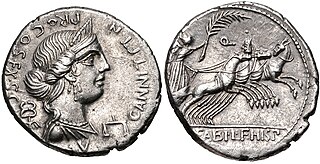The 160s decade ran from January 1, 160, to December 31, 169.
Faustina may refer to:

Annia Aurelia Galeria Lucilla or Lucilla was the second daughter of Roman emperor Marcus Aurelius and Roman empress Faustina the Younger. She was the wife of her father's co-ruler and adoptive brother Lucius Verus and an elder sister to later emperor Commodus. Commodus ordered Lucilla's execution after a failed assassination and coup attempt when she was about 33 years old.
Pomponia is the female name for the Pomponia gens of Ancient Rome. This family was one of the oldest families in Rome. Various women bearing this name lived during the Middle and Late Roman Republic and the Roman Empire. The oldest known Pomponia was mother of a famous Roman general; the second and third were related to each other. The relationship between these women, if any, is not known. They descended from Pomponius, the first son of Numa Pompilius, the second King of Rome.

Annia Aurelia Faustina was an Anatolian Roman noblewoman. She was briefly married to the Roman emperor Elagabalus in 221 CE and thus was a Roman empress. She was Elagabalus' third wife.
Marcus Annius Verus was the paternal grandfather and adoptive father of the Roman Emperor Marcus Aurelius, and father-in-law of emperor Antoninus Pius.

Annia Cornificia Faustina was the youngest child and only daughter of the praetor Marcus Annius Verus and Domitia Lucilla. The parents of Cornificia came from wealthy senatorial families who were of consular rank. Her brother was the future Roman emperor Marcus Aurelius, and both were born and raised in Rome.
Marcus Annius Libo was a Roman Senator active in the early second century AD.

The gens Annia was a plebeian family at ancient Rome. Livy mentions a Lucius Annius, praetor of the Roman colony of Setia, in 340 BC, and other Annii are mentioned at Rome during this period. Members of this gens held various positions of authority from the time of the Second Punic War, and Titus Annius Luscus attained the consulship in 153 BC. In the second century AD, the Annii gained the Empire itself; Marcus Aurelius was descended from this family.
Gnaeus Claudius Severus was a Roman senator and philosopher who lived in the Roman Empire during the 2nd century AD.
Marcus Ummidius Quadratus Annianus (138–182) was a Roman Senator and the nephew of the Emperor Marcus Aurelius. He was involved in an unsuccessful plot to assassinate his cousin the Emperor Commodus, which led to his execution afterwards.
Ummidia Cornificia Faustina was a wealthy Roman noblewoman, an heiress and the niece of the Roman Emperor Marcus Aurelius.
Tiberius Claudius Severus Proculus was a Roman Senator. Via his mother he was a grandson of Emperor Marcus Aurelius, but he played only a limited role in dynastic politics.
Annia Faustina was a noblewoman of Anatolian Roman descent and a wealthy heiress who lived in the Roman Empire. She was a mother-in-law of the emperor Elagabalus.
Pomponius Bassus was a Roman senator active during the reigns of Septimius Severus, Caracalla, and Geta.
Pomponius Bassus [...]stus was a Roman Senator of Anatolian descent who lived in the Roman Empire.
Flavius Antiochianus was a prominent Roman politician during the reigns of the emperors Gallienus, Claudius Gothicus, Quintillus and Aurelian, in the period referred to as the Crisis of the Third Century in the Roman Empire.
The gens Ummidia was a Roman family which flourished during the first and second centuries. The first member of the gens to achieve prominence was Gaius Ummidius Durmius Quadratus, governor of Syria during the reigns of Claudius and Nero. The Ummidii held several consulships in the second century, and through the marriage of Gaius Ummidius Quadratus Annianus Verus they were related to the emperor Marcus Aurelius.
Gaius Ummidius Quadratus Sertorius Severus was a Roman senator active during the second century AD. He was suffect consul in absentia for the nundinium of May to June 118 as the colleague of the emperor Hadrian. He is more frequently known by his shorter name, Gaius Ummidius Quadratus; his full name was known only after a missing piece to an inscription from Tomis was found.
Gaius Ummidius Quadratus Annianus Verus was a consul suffectus around the year 146 CE.